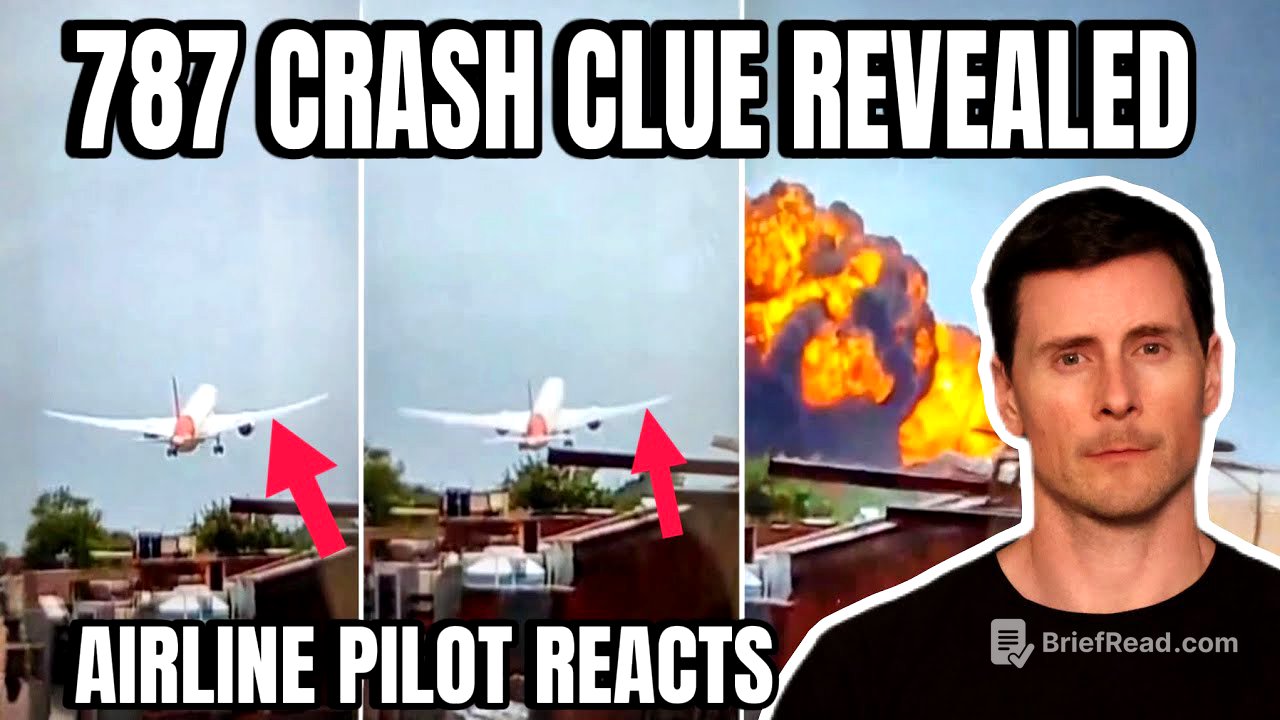TLDR;
Ryan, a former F-15E fighter pilot, F-16 Thunderbird pilot, Boeing 737 pilot, and Airbus A220 pilot, shares his insights on the tragic crash of Air India Flight 171. He expresses his condolences to the families of the victims and emphasizes the overall safety of air travel. He analyses the video footage of the crash, discusses potential causes such as engine failure, maintenance issues, and pilot error, and highlights the importance of rigorous maintenance and pilot training.
- Condolences and support for the victims and their families.
- Reassurance about the safety of air travel despite the tragedy.
- Analysis of potential causes including engine failure, maintenance issues, and pilot error.
- Emphasis on the importance of rigorous maintenance and pilot training.
Introduction and Condolences [0:00]
Ryan introduces himself and the purpose of the video: to discuss the Air India Flight 171 crash. He expresses his sympathy and support for the families of the victims, including passengers, crew, and those on the ground. He acknowledges the estimated 242 fatalities on board and the possibility of casualties on the ground. He also wants to reassure viewers about the safety of flying, despite this incident.
Initial Video Analysis [0:14]
Ryan begins analysing the video of the crash, noting the thin appearance of the wings on the Boeing 787. He explains the standard procedures during takeoff, including the roles of the pilot flying and the pilot monitoring, the timing of retracting the landing gear, and the importance of maintaining flap settings until reaching a safe speed. He finds it strange that the flaps appear to be retracted in the video, as they would typically be used in an emergency landing situation to slow the aircraft down.
Crash Site and Airport Overview [4:54]
Ryan transitions to a map of the crash site, pointing out the location relative to Runway 23 from which the 787 took off. He uses an airport diagram to illustrate the runway length (11,500 feet) and the likely taxi route the plane would have taken from the international terminal, noting the absence of a parallel taxiway to Runway 23. He estimates the takeoff point for a fully loaded 787 and explains the typical sequence of gaining positive vertical velocity, retracting the gear, and gradually retracting the flaps.
Detailed Analysis of the Crash [6:55]
Ryan provides details about the crash of Air India Flight 171, which occurred on June 12, 2025, killing 242 people. He notes that this was the first fatal crash for the Boeing 787. The flight, en route from Ahmedabad to London Gatwick, crashed shortly after takeoff, reaching a maximum altitude of only 625 feet before impacting a residential area. The crew sent out a distress signal before losing contact. The accident is being investigated by the Indian Aircraft Accident Investigation Bureau.
Theories and Potential Causes [8:27]
Ryan discusses several theories regarding the cause of the crash. One theory suggests a dual engine failure or significant thrust loss in the General Electric GEnx engines. Evidence indicates the landing gear was still extended, potentially due to a hydraulic system failure linked to engine performance. Other theories involve incorrect takeoff performance calculations or issues related to recent refurbishment work. He personally believes the crash is unrelated to past quality control issues with the 787.
Possible Scenarios for Engine Failure [9:50]
Ryan explores potential causes for a dual engine failure, including fuel contamination, bird strikes, and mechanical failure. He notes that bird strikes are possible, referencing the US Airways Flight 1549 incident, but the weather was clear at Metabod. He also considers systemic issues with the aircraft's electronic systems, which could disrupt engine control, and maintenance errors during the recent refurbishment. He emphasizes that pilots are trained to detect and address such issues before takeoff.
Boeing 787 Overview and Safety [12:18]
Ryan provides an overview of the Boeing 787 Dreamliner, highlighting its advanced technology, fuel efficiency, and passenger comfort features. He mentions past challenges, such as lithium-ion battery fires and quality control issues, but emphasizes the aircraft's redundant systems and strict global aviation safety standards. He notes that while the crash is a reminder that even advanced aircraft can experience failures, air travel remains statistically very safe.
Preventative Measures and Industry Response [14:16]
Ryan discusses measures to prevent future tragedies, including rigorous maintenance protocols, enhanced pilot training for low-altitude emergencies, and the importance of reviewing dual engine failure scenarios. He notes that Boeing and General Electric are supporting the investigation, and black box data will be crucial in identifying the specific causes of the crash. He also suggests that real-time flight data monitoring and predictive maintenance technologies could help detect issues before they escalate.
Professional Pilot Opinion and Conclusion [15:33]
Ryan shares his professional opinion, suggesting that the crash may not have been caused by engine failure. He speculates that a pilot error involving premature flap retraction could have led to a stall-like condition, even if the engines were functioning normally. He suggests a scenario where the co-pilot inadvertently retracted the flaps after the captain called for gear retraction, leading to a dangerous situation. He concludes by stating that a full investigation is underway and promises to provide updates as they become available.









